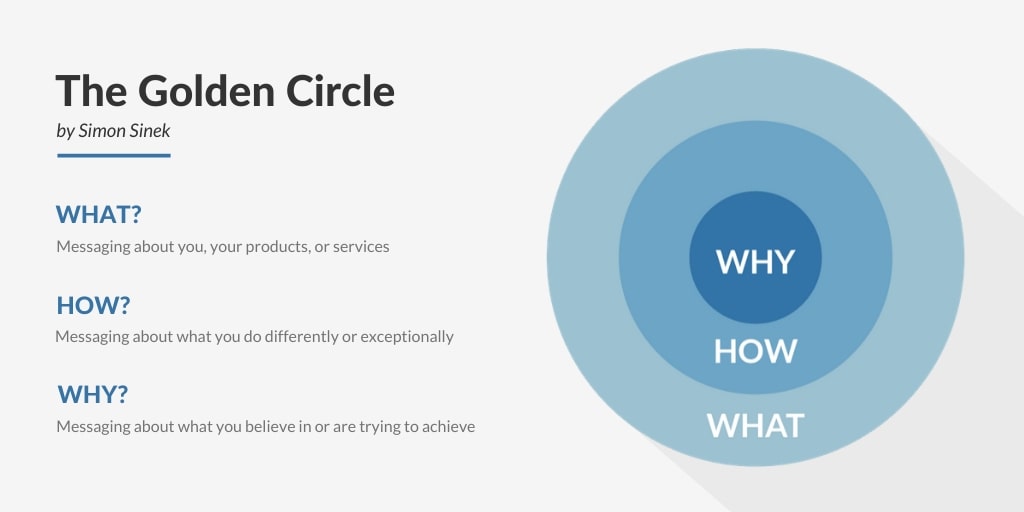When you think about marketing messaging, what comes to mind? Do you start with your products, your company, or the features or benefits you offer that no one else does? Those are all solid pieces of information to communicate to potential clients. But how often do you talk to your audience about your company values?
I recently re-watched an old Ted Talk (Simon Sinek’s “Start with Why”) and was reminded of how often people overlook this essential component of their marketing message. The video is from 2009 but every time I watch it, it inspires me slightly differently. It makes me pause and re-evaluate how I operate — and the messages I put out in the world to (and for) our clients.
*Note: the video that we refer to has been taken down. However, here’s a link to the book if you’re one of the only people in this world who hasn’t read it yet! Click Here
What’s the Secret to Success?
“The goal is not to sell to people who need what you have, the goal is to sell to people who believe what you believe.”
One of the examples Sinek uses in his talk is a comparison between Apple and Dell. Both are technology companies with significant resources, money, and talent at their disposal. But Apple has built an empire of loyal followers who buy its phones, watches, and headphones and subscribe to its music and TV services. Dell…sells computers.
What’s the difference?
Granted, Dell has more of an enterprise focus than Apple. But even in the consumer space, how did Apple become one of the largest media and technology companies in the world when it started out on effectively equal footing with Dell? Are Apple’s products that much better? Do they have some secret advantage? They do. And it’s the way they market their company values.
Get to Know the Golden Circle
Marketing company values? Really?
I know it might sound crazy. After all, you’re in business to provide a product or service. Not to share your beliefs. However, an Accenture study found that nearly two-thirds (63%) of consumers prefer to purchase products and services from companies that stand for a purpose that reflects their own values and beliefs — and will avoid companies that don’t.
So, while you don’t have to turn your organization into a religion, as Sinek explains in his talk, you should consider the science of how consumers process information.
The “Golden Circle” is an image Sinek uses to explain the correlation between marketing messages and the way the human brain processes that information.

Most companies use marketing to communicate what they do. What products they sell, what services they offer. Some organizations go a step further and talk about how they do what they do. What differentiates them from their competitors. But a company with a really good marketing strategy goes right to the centre of the circle to address why they do what they do. In other words, they talk about their company values.
Why Talk About Company Values?
The why in Sinek’s golden circle speaks to the very reason that your organization exists. And communicating those company values speaks to the part of the brain that is responsible for decision-making.
Let’s look at the circle as a table instead.

If you could choose which part of your leads’ brains you’d reach with your marketing, which would you pick? The part where they understand your words and use rational thought to decide if they want to work with you? Or the part where you directly affect their decision-making?
It’s a pretty simple choice.
Getting It Backward
Many marketing strategies focus on the outside of the circle and try to move inward. They talk about who they are and what they do and hope to achieve some kind of buy-in. The vast majority of businesses stop there and never go further. This tactic conveys the features and benefits of their offering to consumers, but doesn’t necessarily compel them to buy it.
Big successes come at it backward. They start with the why in the centre of the circle and move outward. They convey their company values. They talk about why they do what they do and what they’re hoping to achieve. And that message taps into the decision-making part of the brain. As Sinek says:
“People don’t buy what you do, they buy why you do it.”
Loyal Apple buyers probably think the products they buy from the company are great. But they aren’t buying them for the sleek designs, and they aren’t buying them because they think that Dell’s products are inherently bad. They’re buying into Apple’s philosophy of challenging the status quo, of thinking differently.
By sharing their company values in their marketing, Apple has created a personal connection with consumers. And a link like that doesn’t just increase the likelihood of a purchase — it inspires loyalty and advocacy.
Company Values in Cloud and SaaS
Most of the companies we work with here at TPM aren’t selling to end consumers like Apple. But that doesn’t mean we shouldn’t try to convey their company values.
Looking around at the industry we serve, I see an awful lot of what messaging and very little why.
- “We build scalable, hybrid solutions for your business.”
- “Count on us for secure, cost-effective custom solutions.”
- “Choose us for reliable, scalable, easy-to-use platforms.”
Do any of those statements make you want to run out and sign a contract? Imagine what a cloud or technology company could do if they started with the why and shared their company values and goals. There’s a genuine possibility they’d revolutionize their industry.

How Do We Get to the Why?
Developing a marketing message that goes beyond just talking about your products to convey your company values and goals can be challenging. Especially in the tech industry, where competition is thick and differentiation is hard to achieve.
After realizing how many of our clients struggle with this aspect of marketing, the team at TPM developed a strategy to help companies dig a little deeper and start heading toward the why. We call it the XYZABC framework.
Let’s start with one of those non-descript lines from above to demonstrate how effective why messaging can be:
- “We build scalable, hybrid solutions for your business.”
That’s what that business does. Let’s dig a little deeper. How do they provide their customers with that “what”?
- “We work with our customers to identify their unique hosting requirements.”
OK, we’re getting there. But to get to the why and market straight to that decision-making brain, we need to identify their company values, purpose, and beliefs. For example:
- “We believe that migrating to the cloud should be a seamless experience for our customers.”
Now put them all together, starting with the why and working outward from the centre of the circle:
- “We believe that migrating to the cloud should be a seamless experience for our customers. We work with our customers to identify their unique hosting requirements and deliver secure, reliable, cost-effective custom solutions.”
Doesn’t that make you feel warm and fuzzy?
Obviously, there isn’t an exact formula for coming up with why you do business or what your team believes in. But the XYZABC strategy is a good starting point to get you thinking more carefully about who you are and why you’re different — and from there, you’re well on your way to identifying your why.
Tell Your Audience What You Stand For
Communicating your company values isn’t just a good strategy. It’s the best possible way to inspire your audience and drive the behaviours you want from them. Start with the why, and move on to the how and what once you’ve already got their attention.
What you believe in means everything to your customers. If your company has a purpose — and you can effectively communicate it to the masses — there will be no stopping you.
Communicating why you do what you do will make people believe in you.
Do you need help defining your why? Are you struggling to communicate your company values or goals? Talk to the experts at Total Product Marketing today and let us help you build your own XYZABC framework.
